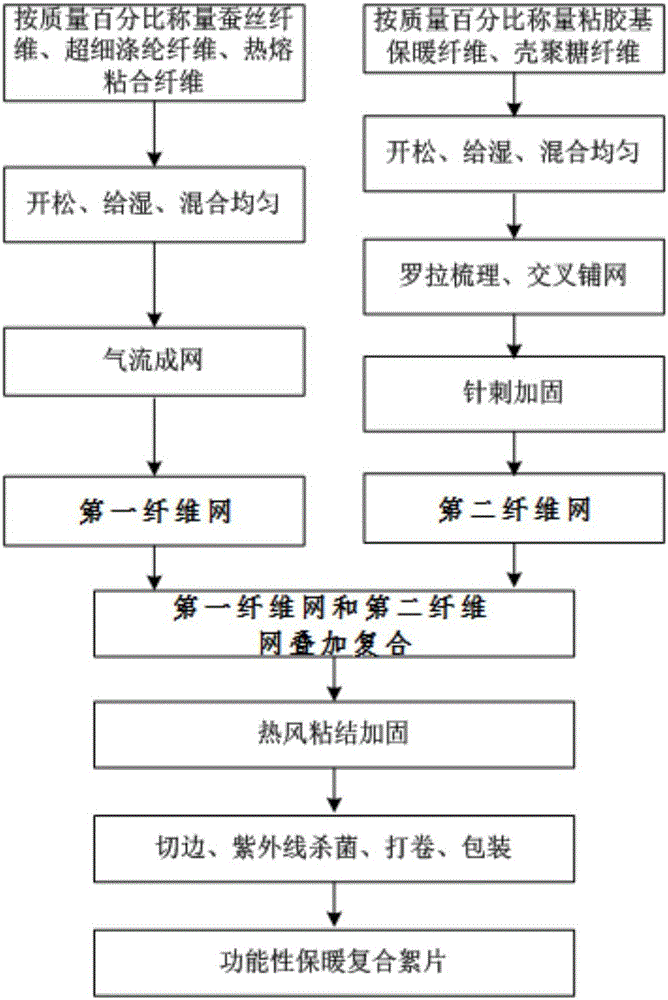Preparation method of functional warm-keeping composite interlining
A functional, flake technology, applied in textiles and papermaking, non-woven fabrics, adhesives, etc., can solve problems such as uneven mixing and the development of functional flakes, and achieve the effect of improving grades
- Summary
- Abstract
- Description
- Claims
- Application Information
AI Technical Summary
Problems solved by technology
Method used
Image
Examples
Embodiment 1
[0024] Embodiment one: see figure 1 Shown, a kind of preparation method of functional thermal insulation composite wadding comprises the following specific steps:
[0025] Step 1) using silk fiber, superfine polyester fiber and hot-melt adhesive fiber as fiber raw materials, wherein the silk fiber is refined dry cotton through scouring, and its fiber length is 38mm; the fineness of the superfine polyester fiber is 0.78dtex and a length of 38mm; the hot-melt adhesive fiber is a low-melting bicomponent composite fiber with a fineness of 1.56dtex and a length of 38mm; according to the mass percentage, it is 80% of silk fiber, 15% of superfine polyester fiber and 5% of hot-melt adhesive fibers, these three kinds of fiber raw materials are weighed, loosened, wetted respectively, and mixed evenly, and then air-laid is used to obtain the first fiber web, and the surface of the first fiber web is The density is controlled at 120g / m 2 ;
[0026] Step 2) Viscose-based thermal insulat...
Embodiment 2
[0029] Embodiment two: see figure 1 Shown, a kind of preparation method of functional thermal insulation composite wadding comprises the following specific steps:
[0030] Step 1) using silk fiber, superfine polyester fiber and hot-melt adhesive fiber as fiber raw materials, wherein the silk fiber is refined dry cotton through scouring, and its fiber length is 38mm; the fineness of the superfine polyester fiber is It is 0.78dtex, and the length is 38mm; the hot-melt adhesive fiber is a low-melting bicomponent composite fiber, and its fineness is 1.56dtex, and the length is 38mm; according to the mass percentage, it is 50% of silk fiber, 35% of superfine polyester fiber and 15% of hot-melt adhesive fibers, these three kinds of fiber raw materials are weighed, loosened, wetted respectively, and mixed evenly, and then air-laid is used to obtain the first fiber web, and the surface of the first fiber web is The density is controlled at 90g / m 2 ;
[0031] Step 2) Viscose-based t...
Embodiment 3
[0034] Embodiment three: see figure 1 Shown, a kind of preparation method of functional thermal insulation composite wadding comprises the following specific steps:
[0035] Step 1) using silk fiber, superfine polyester fiber and hot-melt adhesive fiber as fiber raw materials, wherein the silk fiber is refined dry cotton through scouring, and its fiber length is 38mm; the fineness of the superfine polyester fiber is 0.78dtex and a length of 38mm; the hot-melt adhesive fiber is a low-melting bicomponent composite fiber with a fineness of 1.56dtex and a length of 38mm; according to the mass percentage, it is silk fiber 60%, superfine polyester fiber 30% and 10% of hot-melt adhesive fibers, these three kinds of fiber raw materials were weighed, loosened, wetted, and mixed uniformly, and then air-laid to obtain the first fiber web, and the surface of the first fiber web was The density is controlled at 130g / m2 ;
[0036] Step 2) Viscose-based thermal insulation fiber and chitosa...
PUM
| Property | Measurement | Unit |
|---|---|---|
| Areal density | aaaaa | aaaaa |
| Areal density | aaaaa | aaaaa |
| Length | aaaaa | aaaaa |
Abstract
Description
Claims
Application Information
 Login to View More
Login to View More - R&D
- Intellectual Property
- Life Sciences
- Materials
- Tech Scout
- Unparalleled Data Quality
- Higher Quality Content
- 60% Fewer Hallucinations
Browse by: Latest US Patents, China's latest patents, Technical Efficacy Thesaurus, Application Domain, Technology Topic, Popular Technical Reports.
© 2025 PatSnap. All rights reserved.Legal|Privacy policy|Modern Slavery Act Transparency Statement|Sitemap|About US| Contact US: help@patsnap.com


